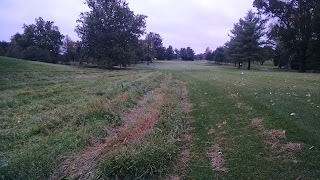Happy Holidays.
 |
| Sprinkler head that needs to be raised |
During the slower months of the winter, we try and tackle
some of the projects that can’t be easily done during the summer. Repainting
tee markers and ball washers are two indoor tasks that aren’t easily
accomplished during the busy months because those accessories are needed on the
golf course. As the weather allows we also work on some outside projects, like
trimming trees, that are easier when there are fewer golfers on the course. This
year, another outside task that we have started is raising sprinkler heads.
 |
| Another angle of sprinkler head that needs to be raised |
Over time, sprinkler heads settle into the soil or the soil
around them is raised through topdressing and they become too low in relation
to the surrounding area. This causes a couple of main issues. First, the
coverage and uniformity of water distribution is severely compromised. The stream
of water that flows from the nozzle can be deflected by the grass and soil that
surrounds the sprinkler. This leads to poor coverage, some areas don’t receive
the intended water because it is knocked down, and then it flows to an area
that was already receiving water and that area becomes too wet. The wet areas
are usually right near the sprinkler and a puddle will even sometimes form,
impacting maintenance and golfers. Second, this wet area affects playability.
The puddle that forms around the head can lead to poor conditions from which to
hit or walk. The rules of golf provide for relief from standing water, but not
form soggy soil where no water is visible, so we are working to eliminate
overly wet areas that are a result of sprinklers.
There are roughly 1,100 sprinkler heads on the golf course. We
are by no means attempting to raise them all. Most of the sprinklers on the
course don’t need to be raised and it would take too long anyway. To start
with, we are focusing on sprinklers around greens only, since these have the
most impact for agronomics and playability; the most important turf to water on
the course is the putting greens and the most important shots hit on the golf
course are on or around the putting greens. Selecting these particular
sprinklers first allows us to finish a segment of the irrigation system. Rather
than start on the first head on the first tee and slowly work down the first
hole, we are zeroing in on our most important area. If we simply worked in
order it would take at least one full off-season to complete all low sprinklers
on an entire hole, so it would be many years before we reached a problem
sprinkler at 13 green for example.
 |
| Completed sprinkler |
As mentioned, this project would be difficult during the
busy golf season because our staff would constantly be in the way of the
golfers. However, working on this project in the winter can be equally as
challenging. Frost slows us down and frozen or snow covered ground stops us
completely. So far this fall/early
winter we have raised 28 heads around greens and we are finished through #9. We
will skip 11, 12, and 13 greens and save those sprinklers for construction
time, so our goal is to finish all of the greens’ sprinklers by spring.
 |
| Another angle of completed sprinkler |
The relatively mild start to winter has allowed us to get a
good portion of this project completed already. Mother Nature will put the
brakes on us soon enough, but we will pick back up before the golf season kicks
off next year.
Etiquette Reminder of the Month
Please do not try and remove a flagstick that is frozen into the
cup. Turf damage may occur.
See you on the course!
Joe
jvillegas@bwrc.org














































